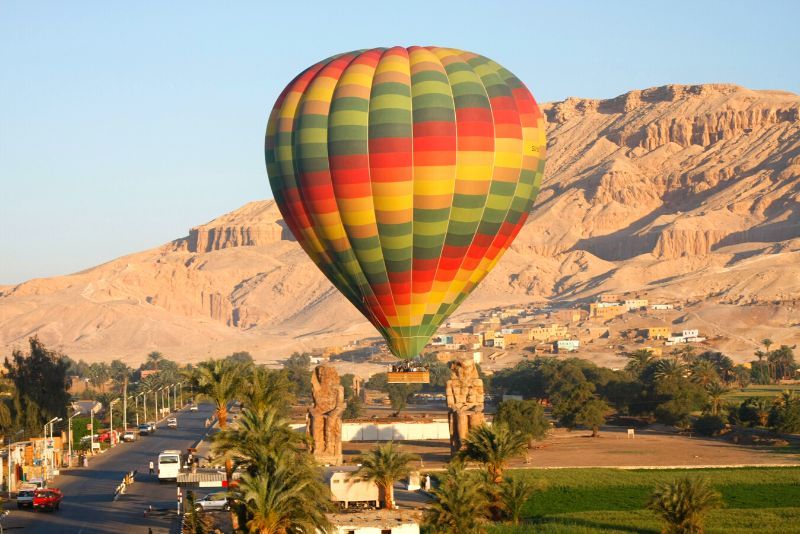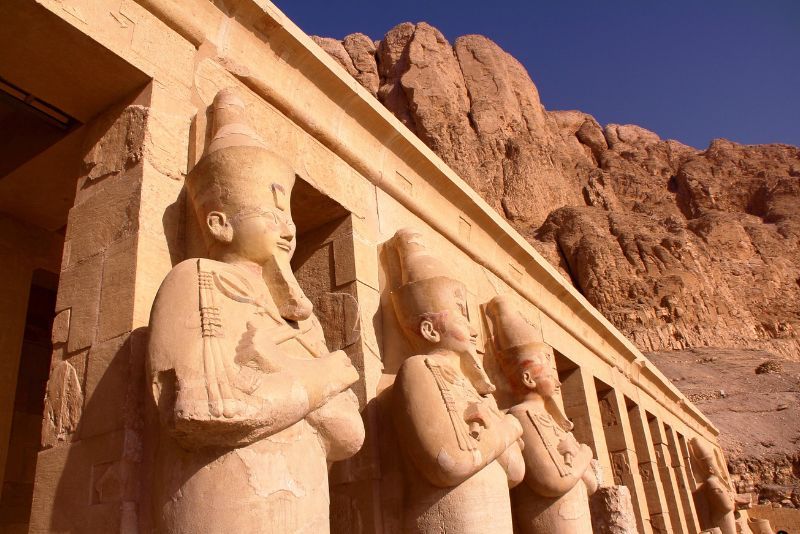Hatshepsut Temple: Tickets and Tours
Hatshepsut Temple is a testament to history that still proudly stands in Luxor, Egypt. Erected by Queen Hatshepsut herself in 1479 B.C., the ancient building tells the fascinating story of her life as Egyptian royalty.
The grand temple was masterfully designed over the course of 15 years with rows of columns and a magnificent sloping entryway, transporting visitors to the distant past.
Hatshepsut Temple is a testament to history that still proudly stands in Luxor, Egypt. Erected by Queen Hatshepsut herself in 1479 B.C., the ancient building tells the fascinating story of her life as Egyptian royalty.
The grand temple was masterfully designed over the course of 15 years with rows of columns and a magnificent sloping entryway, transporting visitors to the distant past.

(0/24) checking Musement...
Hatshepsut Temple is a testament to history that still proudly stands in Luxor, Egypt. Erected by Queen Hatshepsut herself in 1479 B.C., the ancient building tells the fascinating story of her life as Egyptian royalty.
The grand temple was masterfully designed over the course of 15 years with rows of columns and a magnificent sloping entryway, transporting visitors to the distant past.
Book a tour of Hatshepsut Temple to explore colonnades, chapels and sanctuaries that make up the harrowed halls of the ancient building.

Here's all you need to know about Hatshepsut Temple, one of the most exciting attractions in Egypt.
How much do Hatshepsut tickets cost?
Foreigners
- Adults: €5
- Student: €3
Egyptians/Arabs
- Adults: €2
- Students: €1
Tickets to Hatshepsut Temple include access to all three building levels, including the courtyard where the Mummiform statues of Hatshepsut reside.
Who is eligible for discounts?
Egyptians, Arabs and students are eligible for discounts on ticket prices.
Should you book in advance?
Book your visit to Hatshepsut Temple in advance for skip-the-line access and to explore the historic landmark with an experienced guide.
Are there any combined tickets or tours including Hatshepsut Temple and other attractions?
Private tour of Hatshepsut Temple plus Luxor West Bank and Valley of the Kings

This popular 4-hour tour covers several of Egypt’s most revered monuments with the help of a private guide. You’ll begin with hotel pickup in Luxor where you’ll embark on your journey to the west bank of the Nile River.
While you ride, your driver will regale you on tales of the Valley of Kings where some of the most elite members of Egypt’s upper class resided in the 18th, 19th and 20th dynasties.
Your first stop will be the ancient city of Thebes where you’ll visit the burial site of the King of Thebes himself. You will peruse the lavishly decorated rooms, and have the option to visit the tomb of King Tutankhamun at an extra fee.
After you depart from the blazing desert of the Valley of Kings, you’ll head to the Temple of Hatshepsut, considered one of the most striking monuments in Egypt.
Your professional guide will tell the fascinating stories of the temple and the Queen herself, the famous female sovereign who pretended to be male to occupy the throne.
You’ll have plenty of time to wander the courtyards and intricate hieroglyphic artwork displays at your own leisure.
On your way back to Luxor, you’ll hit one final stop at the Colossi of Memnon for a quick photo op. This temple is where Amenhotep III was buried, marked in modern times by only two remaining statues that stand tall on the west bank of the Nile. You’ll finish your excursion with a hotel drop-off.
2-Day tour of Hatshepsut Temple plus Temple of Karnak
Extend your tour of the ancient Luxor sights to a 2-day excursion along the banks of the Nile. This longer trip begins with a hotel pickup, from where you’ll head first to the Temple of Karnak.
Once considered the most important religious complex in Egypt, the temple was developed over the span of 1,000 years between the 12th and 20th dynasties. From there, you’ll continue on to the Luxor Temple built by Amunhotep III but completed by the most famous King of Egypt, Ramesses II who ruled for 67 years.
Finish with a visit to the Obelisk of Ramses II in front of the 1st Pylon before heading back to Luxor to conclude the first day.
Day two tackles the Valley of the Kings, the Temple of Hatshepsut and the Colossi of Memnon. Learn from your guide just how influential Hatshepsut was for Egypt, as she is believed to have started one of the first major trading routes for the empire.
Guided tour of Hatshepsut Temple plus hot air balloon ride

Combine your exploration of ancient Luxor with a thrilling hot air balloon ride high above the various monuments. This excursion begins with a hotel pickup from where you’ll cruise along the west bank of the Nile River.
You’ll stop for a quick breakfast before boarding your hot air balloon for take-off. Sail high into the sky for an exciting 45-minute ride over the biggest “open-air museum.” Catch sight of monuments from thousands of years ago, preserved excellently in time.
During the beautiful ride, you’ll have plenty of opportunities to snap stunning photos of ancient Luxor.
After the hot air balloon adventure, you’ll board a transport vehicle to explore the great West Bank. You’ll see the 63 tombs scattered throughout the Valley of Kings, including that of King Tutankhamun, and learn the rich history of the region and what went on there.
Venture on to the Temple of Hatshepsut at Deir el Bahari and pass by Colossi of Memnon before finishing out your tour with an optional cruise down the Nile or a hotel drop-off.
What will you see inside?

The incredible Hatshepsut Temple is a breathtaking site, constructed with dozens of large columns and a huge sloping ramp to the entrance.
The monument is a pristine example of the exquisite architecture of ancient Egypt and one of the finest remaining landmarks from ancient Luxor. The temple itself consists of three different levels, each with its own colonnade.
The ground level was once a flourishing garden, but now holds colorful decorations and artwork from Lower Egypt. The second level has two reflecting pools and two sphinxes, as well as a pictorial image of the first trade expedition.
There is a shrine for the Goddess Hathor, a birth colonnade that tells the story of Hatshepsut’s creation and a punt colonnade that depicts her expedition to the “Land of the Gods.”
Two chapels, the Hathor Chapel and Anubis Chapel, boast stunning columns and astronomical ceilings. The third level contains a portico with walls of artwork reflecting King Tutmosis III, who wiped the temple clean of Hatshepsut’s murals during the time of his rule.
Finally, behind the courtyard sits the sanctuary of Amun which was rebuilt during the Ptolemaic Period.
How to get there?
The Temple of Hatshepsut is located 27 km northwest of Luxor along the West Bank. In order to get to the monument you must either hire a driver, get a taxi or book a bus tour.
What are the opening times?
The temple is open every day of the week from 6AM until 5PM.
Is it wheelchair friendly?
Parts of the exhibit are wheelchair accessible, although certain areas may not be due to the historic nature of the building.
When is the best time to visit the Hatshepsut Temple?
The best time to visit the Hatshepsut Temple in Luxor, Egypt is during the cooler months, specifically from November to February. It's advisable to visit in the morning or late afternoon to avoid the peak heat of the day.
Summers in Luxor can be extremely hot, so it's best to avoid visiting the temple during that time if possible.
Which other attractions can be visited in Luxor?
Travel tips
- Stay hydrated and bring essentials like water, sunscreen, and comfortable shoes.
- Explore nearby attractions like the Valley of the Kings and Valley of the Queens.
- Visit early to avoid crowds as the Hatshepsut temple can get crowded as the day progresses, so it's recommended to arrive early in the morning.
- Dress modestly, as a sign of respect, when visiting the temple both men and women should cover their shoulders and knees.

